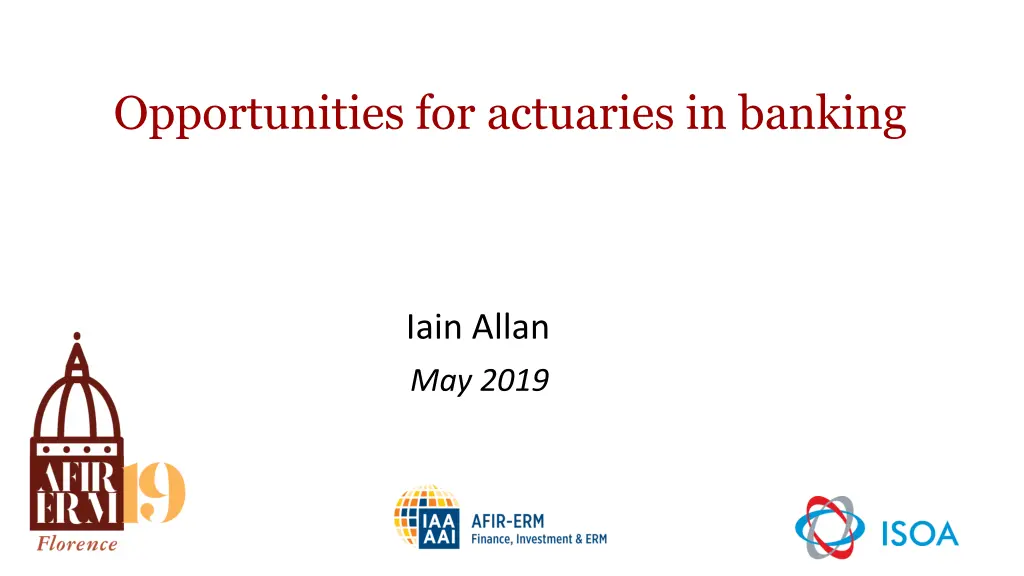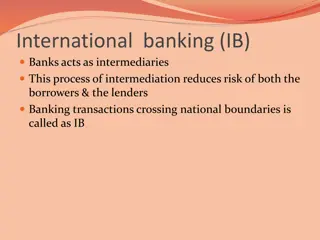
Actuarial Opportunities in Banking and Insurance Industry
Explore the diverse roles of actuaries in banking and insurance sectors, including quantification of capital requirements, regulatory submissions, and strategic partnerships. Learn from the experience of industry expert Iain Allan as he navigates through different facets of the financial landscape.
Download Presentation

Please find below an Image/Link to download the presentation.
The content on the website is provided AS IS for your information and personal use only. It may not be sold, licensed, or shared on other websites without obtaining consent from the author. If you encounter any issues during the download, it is possible that the publisher has removed the file from their server.
You are allowed to download the files provided on this website for personal or commercial use, subject to the condition that they are used lawfully. All files are the property of their respective owners.
The content on the website is provided AS IS for your information and personal use only. It may not be sold, licensed, or shared on other websites without obtaining consent from the author.
E N D
Presentation Transcript
Opportunities for actuaries in banking Iain Allan May 2019
Opportunities for actuaries in banking Opportunities for actuaries in banking Banking Seminar, Washington, 14 May 2019
Opportunities for actuaries in banking Opportunities for actuaries in banking Experience in banking Quantification of capital requirements and buffers Retail banking product pricing and profitability
Iain Allan Iain Allan Movement into banking Movement into banking 1969-74 1974-79 1979-85 1985-91 Scottish Life UK Provident Phillips & Drew* UBS Fund management Fund management Stockbroking Investment banking *In 1985, Phillips & Drew was acquired by UBS
Iain Allan Iain Allan Experience in banking Experience in banking 1994-2008 Group Director, Strategy, RBS Supermarket banking joint venture with Tesco Acquisition of NatWest Strategic partnership with Bank of China
Iain Allan Iain Allan Experience in banking Experience in banking 2008-2019 Independent consultant Applications for banking licences by new entrants Regulatory submissions by smaller banks Draft responses to regulatory consultations
Opportunities for actuaries in banking Opportunities for actuaries in banking Quantification of capital requirements and buffers
Insurance companies Insurance companies Solvency II Solvency II Three pillars Pillar 1: Quantification of capital requirements Pillar 2: Supervisory review process Pillar 3: Requirements for public disclosures Regulatory submission Own Risk and Solvency Assessment (ORSA)
Banks Banks Basel regulations Basel regulations Three pillars Pillar 1: Quantification of capital requirements Quantification of liquidity requirements Pillar 2: Supervisory review process Pillar 3: Requirements for public disclosures Regulatory submissions Internal Capital Adequacy Assessment Process (ICAAP) Internal Liquidity Adequacy Assessment Process (ILAAP)
Banks Banks Quantification is fragmented Quantification is fragmented Pillar 1 Minimum capital requirements (Basel regulations) Pillar 2A Additional capital requirements (proposed by bank, set by PRA) Pillar 2B Capital buffers (Minimum Basel regulations/CRR) Additional proposed by bank, set by PRA)
Pillar 1 Pillar 1 Minimum capital requirements Minimum capital requirements Basel regulations/CRR* prescribe methodologies for quantifying credit, market and operational risk *CRR: Capital Requirements Regulations
Pillar 1 Pillar 1 Minimum capital requirements Minimum capital requirements Basel regulations/CRR prescribe methodologies for quantifying credit, market and operational risk Banks can use either standardised approach (SA) or internal risk-based (IRB) approach (internal models)
Pillar 1 Pillar 1 Minimum capital requirements Minimum capital requirements Basel regulations/CRR prescribe methodologies for quantifying credit, market and operational risk Banks can use either standardised approach (SA) or internal risk-based (IRB) approach (internal models) Banks must quantify RWAs for credit risk and equivalent RWAs for market and operational risk
Pillar 1 Pillar 1 Minimum capital requirements Minimum capital requirements Risk weight Mortgages LTV under 50% LTV 70% - 80% Credit cards UK International Corporates Large corporates Mid corporates SME SA IRB (average) 35.0% 35.0% 4.5% 13.9% 75.0% 75.0% 79.6% 112.6% 46.3% 71.6% 59.8%
Pillar 1 Pillar 1 Minimum capital requirements Minimum capital requirements Basel regulations/CRR prescribe methodologies for quantifying credit, market and operational risk Banks can use either standardised approach (SA) or internal risk-based (IRB) approach (internal models) Banks must quantify RWAs for credit risk and equivalent RWAs for market and operational risk Minimum capital requirements are defined as percentages of total RWAs
Pillar 1 Pillar 1 Minimum capital requirements Minimum capital requirements Capital % total RWAs Total Common Equity Tier 1 (CET1) Additional Tier 1 (AT1) Tier 2 (T2) 8% At least 4.5% Up to 1.5% Up to 2%
Pillar 2A Pillar 2A Additional capital requirements Additional capital requirements Areas not captured under Pillar 1 Credit concentration risk Counterparty credit risk Interest rate risk in the banking book (IRRBB) Pension obligation risk In the UK, the PRA has given guidance on methodologies that may be used
Pillar 2A Pillar 2A Additional capital requirements Additional capital requirements Areas that may not be adequately captured under Pillar 1, if using standardised approach Credit risk Market risk Operational risk In the UK, the PRA has given guidance on methodologies that may be used
Pillar 2B Pillar 2B Capital buffers Capital buffers Buffer % total RWAs Set by Buffers set for all banks Capital conservation buffer 2.5% Basel Countercyclical capital buffer Up to 2.5% BoE Buffers set for individual banks Systemic risk buffer Up to 3% BoE PRA buffer n/a PRA
Pillar 2B Pillar 2B Capital buffers Capital buffers PRA buffer ensures that bank does not breach its minimum capital requirements, even under severe stress scenarios: System-wide stress scenarios Bank-specific stress scenarios Combined stress scenarios Bank must also carry out reverse stress test
Pillar 2B Pillar 2B Capital buffers Capital buffers No PRA buffer PRA buffer 5 4.5 4 3.5 3 % total RWAs 2.5 2 1.5 1 0.5 0 ST Basel ST Basel ST: Buffer determined by stress testing; Basel: Buffer set by Basel regulations
Quantification of capital requirements and capital buffers Quantification of capital requirements and capital buffers Why actuaries? Pillar Requirement Pillar 1 Pillar 2A Pillar 2B Compliance with regulations Understanding and judgement Understanding and judgement
Quantification of capital requirements and capital buffers Quantification of capital requirements and capital buffers Why actuaries? In the run up to the financial crisis, financial supervision relied too much on tick-box compliance with rules and directives at the expense of proper in-depth and strategic analysis. Effective prudential regulation of firms requires an approach based on understanding of their business models and the ability to make judgements about the risks that their firms activities pose to themselves and to the wider financial system as a whole. HM Treasury
Quantification of capital requirements and capital buffers Quantification of capital requirements and capital buffers Why actuaries? Some banks have announced their intention to meet the required 9% target ratio through so called RWA optimisation changes in risk measurement methodology the lead to reduction in reported RWAs. Such changes may not result in any improvements in underlying resilience. Bank of England
Quantification of capital requirements and capital buffers Quantification of capital requirements and capital buffers Why actuaries? Actuaries are trained to understand risks and to make judgements about them Actuaries are used to working under professional standards (Code, CPD/PST, Standards) ICAAP covers all areas of business and all types of risk (Enterprise Risk Management)
Quantification of capital requirements and capital buffers Quantification of capital requirements and capital buffers Why actuaries now? IFR39 versus IAS39, from 1 January 2018 IAS39 (incurred loss accounting); Make provisions in event of risk events occurring IFRS9 (expected loss accounting): Make provision for all loans, in three stages: Stage 1: Performing loans: 12 months expected losses Stage 2: Underperforming loans: Lifetime expected losses Stage 3: Non-performing loans: Lifetime expected losses
Quantification of capital requirements and capital buffers Quantification of capital requirements and capital buffers Why actuaries now? IFRS9 (expected losses) versus IAS39 (incurred losses) Base case Lower capital resources (after loss provision) May also be lower capital requirements Stress scenario Expected losses rise rapidly Capital position deteriorates more, and more quickly
IFRS9 versus IAS39 IFRS9 versus IAS39
Quantification of capital requirements and capital buffers Quantification of capital requirements and capital buffers Why actuaries now? Banks need to estimate expected losses under base case conditions and under stress scenarios Banks need to make judgements about buffers in light of IFRS9 versus IAS39 stress tests
Opportunities for actuaries in banking Opportunities for actuaries in banking Retail banking product pricing and profitability
Product pricing and profitability Product pricing and profitability Products Current accounts Deposit accounts Mortgages Credit cards Personal loans
Product pricing and profitability Product pricing and profitability Cash flows for financial model Income Costs Credit losses May be fixed or variable May be direct or shared Need to allow for IFRS9 Capital Liquidity P1/P2A product-specific, P2B shared Balance sheet limits liquidity risk
Product pricing and profitability Product pricing and profitability Why actuaries? Need for understanding and judgement Not rely on deterministic model, base case
Product pricing and profitability Product pricing and profitability Why actuaries? The Bank recognises that all models are simplifications of reality, with both known and perhaps more importantly unknown weaknesses. The results of models are therefore a baseline against which judgement should be applied and are not the answer . Bank of England
Product pricing and profitability Product pricing and profitability Need for understanding and judgement Balance sheet: Maturities of loans, deposits Mortgages: Behavioural shorter than contractual Current accounts: Behavioural longer than contractual Income: Some items depend on customer behaviour Interest income: Expected retention rates Non-interest income: Fees on current accounts
Product pricing and profitability Product pricing and profitability Need for understanding and judgement Costs: Shared costs include IT, Treasury, distribution Allocate shared costs across products May evaluate with/without shared costs Funding costs: regard deposits as profit centre Treasury sets funds transfer pricing rates Rates include term liquidity premium
Product pricing and profitability Product pricing and profitability Need for understanding and judgement Credit losses: Allow for IFRS9 Initial capital for provisions as well as for loans IFRS9 impairments in profit and loss account Capital: Allow for total capital supporting product Pillar1/Pillar2A capital is product-specific Allocate Pillar 2B buffers, allowing for relative risk
Product pricing and profitability Product pricing and profitability Need for understanding and judgement Discount rate for NPV, hurdle rate for IRR Prefer cost of equity capital, but could use weighted average cost of capital Use CAPM for each bank Apply same discount/hurdle rate to all products Differentiation by risk already achieved through amount of capital (including buffers) supporting product
Product pricing and profitability Product pricing and profitability Not rely on deterministic model, base case NPV/IRR model is convenient and straightforward Evaluate sensitivities as well as base case If possible, use an approach that allows for a range of possible outcomes
Product pricing and profitability Product pricing and profitability Why actuaries now? PSD2 (Open Banking in UK) has potential to transform retail banking Customers may authorise transfer of data to approved third parties: Price comparison websites for individuals Information and advice for individuals Personal financial management services Other innovative banking services
Product pricing and profitability Product pricing and profitability Why actuaries now? Product pricing and profitability New entrants seek profitable product/customers Incumbents need to defend market shares/profits Likely shift from product focus to customer focus Use data to evaluate customer relationships Use data to enhance customer relationships
Opportunities for actuaries in banking Opportunities for actuaries in banking Build on existing skills and experience in equivalent activities in insurance and pensions Make effective contribution because of training in understanding risks and in making judgements about them and because of their experience of working under professional standards Opportunities to engage in enterprise risk management and to apply data science techniques
Opportunities for actuaries in banking Opportunities for actuaries in banking Iain Allan Iain.allan1965@gmail.com 43






















